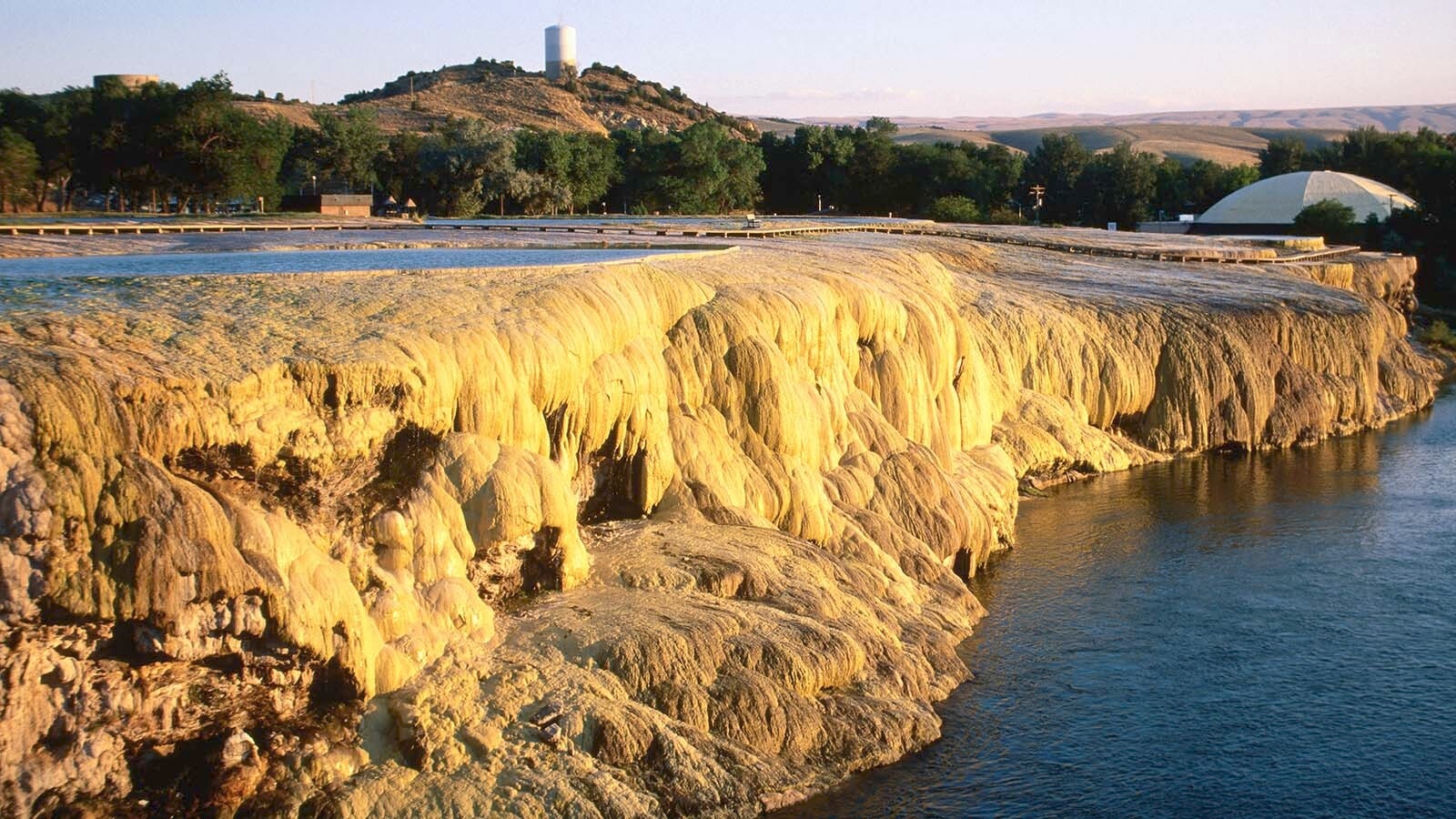When tourists arrive in Thermopolis, one of the first things that they see is Monument Hill and a larger-than-life message emblazoned in white on its westward-facing slope: “World’s Largest Mineral Hot Springs.”
It's an enticing invitation to visit Hot Springs State Park, soak in its therapeutic mineral water, and visit "the Big Spring," which was once measured as the world's largest hot spring.
But is it? Was it ever?
The Big Spring at Thermopolis has a history of ebbing and flowing at various volumes since its mineral water discharge was first measured in 1900. Geologists might place it among the world’s largest mineral hot springs, but claiming it’s “the” largest isn't as accurate as it once was.
“It’s at a decent water level right now, but water levels have declined over the last 100 years,” said Chris Delay, superintendent of Hot Springs State Park. “The Big Spring is still the main source of water for the bathhouse and leases in the park and still sends water over the boardwalks to the terraces, but it’s a fraction of what was measured in 1900.”

What Is ‘Largest?'
Hot Springs State Park was created in 1897 but didn’t get its lofty title as “the world’s largest mineral hot springs” until the discharge of the Big Spring was measured in 1900.
The critical factor in determining “the world’s largest mineral hot spring” isn’t the size or depth of the spring. It’s the measured output of thermal water flowing into it.
“It’s how you measured the volume of water,” said Mark Fisher, retired geologist and contributor to the website Geology of Wyoming, “but even that can be difficult. Do you include one spring or all the springs in a complex? If you did that at Thermopolis, you’d get a much higher volume.”
There are other thermal features within the vicinity of the Big Spring, like the Maytag well at the Fountain of Youth RV Park, but those aren’t factored into the definition of “world’s largest.” To get that title, the Big Spring had to go with its own flow.
According to the first measurement taken in 1900, the Big Spring was discharging 12,500 gallons per minute (gpm).
“That’s an enormous amount of water,” Fisher said.
That incredible measurement increased the notoriety of Thermopolis and the Big Spring worldwide.
Thousands of people flocked to the small community to see and soak in the mineral-rich thermal water, renowned for its healing properties for hundreds of years before white settlers arrived in the Bighorn Basin.
If the Big Spring were discharging that much water today, it would unquestionably be the world's largest mineral hot spring — but it isn't.
In 1926, the Wyoming State Geologist measured the discharge of the Big Spring once again. That measurement was considerably lower at 2,778 gpm.
Going from 12,500 gam to six times less is an incredible drop in water volume in 20 years. That’s why Fisher and other geologists have reasons to be skeptical of what was measured in 1900.
“We don’t know how accurate that initial measurement was,” Fisher said. “Older pictures of the Big Spring showed a doming of the water, which suggests a higher flow rate, so it's hard to say whether the 1900 measurement was accurate or whether things dropped off significantly.”
Not Exactly Straight From The Source
Unlike Yellowstone’s hot springs, the hydrothermal activity in Thermopolis isn’t the result of subterranean volcanism.
Fisher said it’s the result of a complex but commonplace set of geological processes that happen to resurface at Thermopolis.
“When you look beyond the travertine deposits in Thermopolis, there’s a 1,000-foot section of limestone and sandstone,” he said. “Those rocks act as aquifers for water that flows in from elsewhere.”
When rain falls or snow melts in the Owl Creek Mountains, on the southern edge of the Bighorn Basin, a natural fold, called an anticline, forces the water downhill and northward toward Thermopolis.
Rather than forming as a stream on the surface, the water penetrates the ground and flows through several layers of rock buried over a mile under the surface.
As the water gets deeper, it gets hotter. Depending on the depth of the rock it penetrates, the water can reach temperatures between 131 degrees and 178 degrees before being forced back toward the surface.
“Thermopolis is a low spot where the Bighorn River cuts through that anticline, and the heated water resurfaces there,” Fisher said. “It traveled 20 miles northwest of Thermopolis to the point of lowest elevation on the anticline.”
And the minerals? That’s what the water carries away from the rocks it flows through on its subterranean journey from the Owl Creeks to Thermopolis.
The water discharged from the Big Spring maintains a near-constant temperature of 135 degrees. The temperature is moderated as it flows towards the Hot Springs State Park Bathhouse, so residents and tourists can soak at a safer 104 degrees.
Fisher said this isn’t unique to Thermopolis. The same geologic processes have created mineral hot springs around the world, including those at Saratoga.
“It’s nothing special,” Fisher said. “It’s just convection heating and water flowing through hot, warmer rock on its way to the surface.”

World’s Largest?
Thermopolis claims to have the world’s largest mineral hot spring. The Guinness Book of World Records disagrees.
Since the Big Spring feeds the Hot Springs State Park Bathhouse and the two concessionaires in the park, Star Plunge and Hellie’s Tepee Pools, its flow is regularly measured.
“We monitor the Big Springs and other hydrothermal features as much as possible,” Delay said. “Each facility is allowed so much water from the Big Spring, which is the main source of water, and we regularly have conversations about discharge to make sure there’s no wasted water.”
Clay said the most recent measurement, taken earlier this year, showed the Big Spring was discharging 2,027 gpm That’s a significant amount of water, but it falls short of “the world’s largest.”
According to Guinness World Records, the largest hot spring in the world by flow rate is Deildartunguhver in Iceland. Its flow rate is 65 gallons per second, or 3,900 gpm.
That’s over 1,000 gpm more than the current flow rate of the Big Spring. It’s also only a fraction of the initial 12,500 gpm measured at the Big Spring in 1900.
If the Big Spring were measured by its surface area, it wouldn’t even be the largest hot spring in Wyoming. That’s Yellowstone’s Grand Prismatic Spring.
The world’s largest hot spring by surface area, according to Guinness, is Frying Pan Lake in New Zealand at 9.3 acres. By that metric, Grand Prismatic is the world’s third-largest hot spring.
Go Tell It On The Mountain
Thermopolis gained and has retained the title of “world’s largest mineral hot spring” because of that incredible but dubious measurement of the Big Spring’s water volume in 1900.
Even if it has lost that title, Fisher sees categorizing “the world’s largest” as getting caught up in technicalities.
“Regardless of how it’s measured, the Big Spring is a very large hot spring,” he said. “It could be one of the world’s largest, but is it the world’s largest? I would quibble with that.”
Even Clay conceded that the Big Spring isn’t what it once was — if it ever was — and hasn’t been for over a century. Nevertheless, he doesn’t think they’ll be conceding the title or removing it from Monument Hill anytime soon.
“It's one thing we claim,” he said, “but (the Big Spring) isn’t necessarily the world’s largest mineral hot spring anymore.”
Andrew Rossi can be reached at arossi@cowboystatedaily.com.





